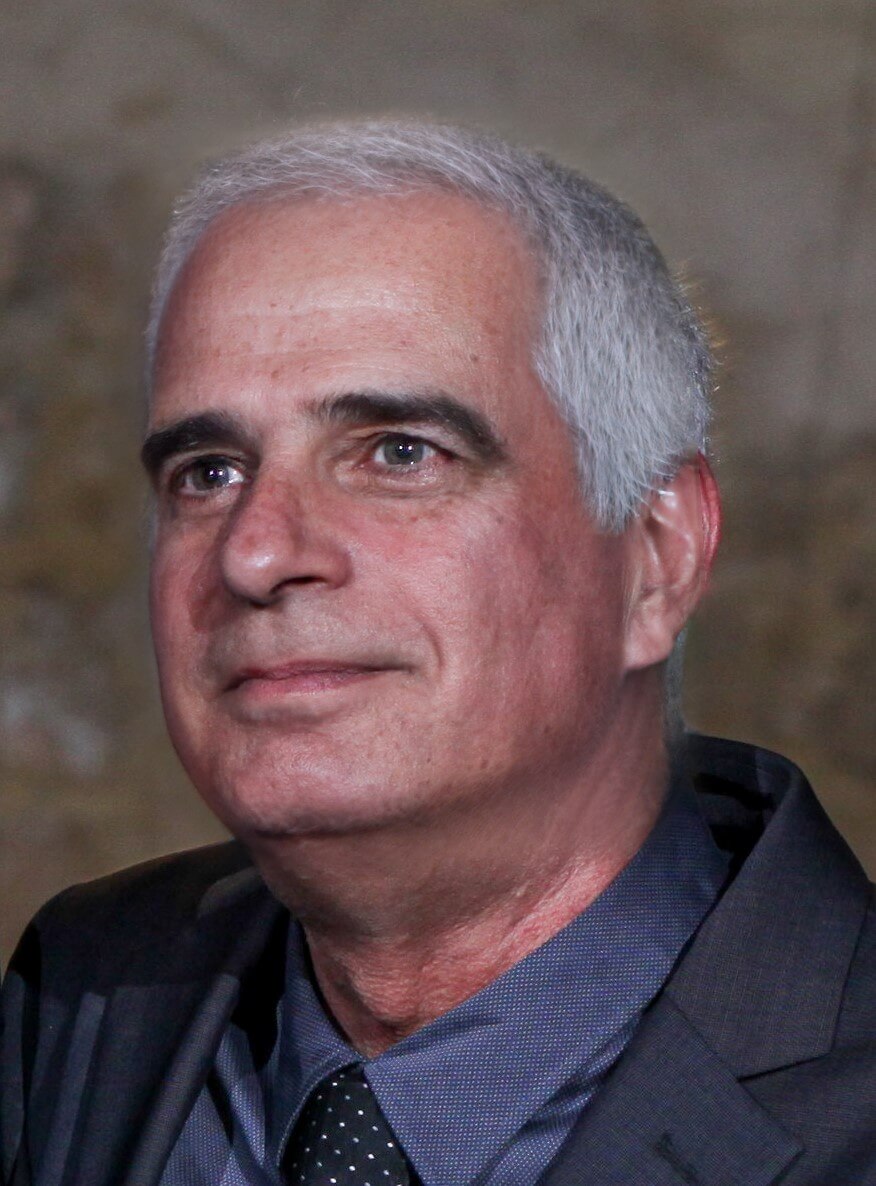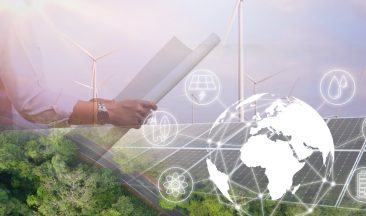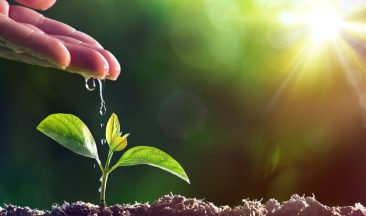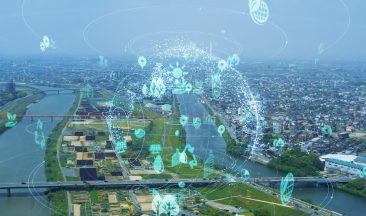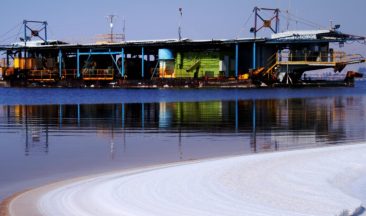Part Two of an interview with Yossi Ron, VP of Energy and Strategic Projects at ICL.
Welcome to Part Two of our interview with ICL’s Yossi Ron. In Part One, Mr. Ron gave us an overview of ICL’s revolutionary Green Sdom Initiative in Israel’s arid Negev Desert. The initiative is an ambitious plan to transform an entire industrial complex, containing a dozen individual plants, into a model enterprise that runs entirely on sustainable green energy. The project is already emerging as a flagship for the establishment of renewable energy in manufacturing plants.
The transformation of the massive Sdom plant is part of ICL’s commitment to the SBTI, the Science Based Targets Initiative, and a 30% carbon footprint reduction by 2030. Mr. Ron already explained the thinking behind the Green Sdom Initiative and the very real challenges – and opportunities – that it entails.
In today’s interview, we’ll be asking Mr. Ron about ICL’s plans to eventually develop an Energy self-sufficient site via implementing a sustainable package and hydrogen economy at the ICL Sdom complex, and how he plans to tackle the challenges of developing a green circular economy in a complex that can easily consume 150 megawatts of electricity and 150 megawatts of thermal energy every hour.
We will also discuss the concepts for a future roadmap for sustainable energy innovation across all of ICL’s diverse global enterprises, and his thoughts on the wider need for renewable energy in industry and the role it can play in improving our lives.
Hi Yossi, welcome back! It’s good to see you again. Last time we met you gave us a hint about the role that hydrogen and PV (Photovoltaics) will play in the new Sdom microgrid. Can you elaborate on the plans?
Yes, first, it’s time to meet the Green Sdom team. Led by Project Manager Yair Rivlin, the project team of professionals includes Nimrod Levy as the Regulation & Authorities lead as well as Economics assisted by Yogev Amar, Tsofia Dublon is in charge of the projects Back Office, Yaniv Steiner and Vladimir Kotlovsky are by now among the country’s leading Hydrogen experts, Amnon Weinberg and Yaakov Mor-Yossef on the PV and electrical infrastructure and Zvi Yonatan is in charge of the assorted energy storage solutions.
Let’s talk more about the role of hydrogen – at least the potential role of hydrogen – as a source of renewable energy in manufacturing. There are three main reasons why we find hydrogen so exciting at ICL:
- It’s a powerful, clean fuel that doesn’t emit any greenhouse gasses when you burn it. When used in a Fuel Cell, the only byproduct is water – and you can’t have too much water in a place like Sdom where the average daily temperature in August touches 40℃! Hydrogen has great potential as a source of green energy in factories.
- The second advantage of hydrogen is that it is an excellent carrier of energy and can be stored as a fuel reserve for future needs. It is currently the best option for a “battery pack” for periods longer than hours/days. If we have a week of gray days when the PV fields are not producing in full, or our microgrid is somehow disrupted, we’ll be able to switch seamlessly to stored hydrogen and continue to supply our energy needs.
One of the current limitations of using green energy in factories is the challenge of storing clean energy in batteries. Feasible solutions for the long-term storage capacity just aren’t there yet.
- The third reason why hydrogen could be amazing for ICL is that in addition to our other enterprises, we are a major fertilizer producer. We can also use hydrogen as an ingredient in fertilizers like green ammonia. Green ammonia is a hot topic in the world these days.
We are also looking at opportunities to use a hydrogen-fired combined cycle to fire turbines and produce electricity and heat for steam. We can significantly reduce dependence on natural gas! As mentioned before “the moment the stars aligned”. Sometimes, everything just falls into place – and it seems that the Green Sdom project is part of that beautiful alignment.
Hydrogen will be a vital component of renewable energy in industry, but it’s not a magic solution – at least not yet. There are some major challenges when it comes to the safe and economically feasible storage of hydrogen. We’ll need to store thousands of tons of highly volatile hydrogen.
One cannot store thousands of tons in cylinders on the surface. It’s just way too hazardous, and expensive, with current technologies. If we want to store hydrogen in industrial quantities, it has to be underground. The most common and viable solution may be to use salt caverns.
It is being developed in many countries as we speak. The Spanish are looking into it and they already approached the IBP team regarding the ICL mine near Barcelona (as a potential site). We also employ a large engineering company from the Netherlands to explore this challenge. We are, together with one of their experts who has specialist knowledge of salt caverns, exploring the potential in the Dead Sea valley. We know what we need to look for and are busy finding workable long-term solutions.
On the plus side, we’re already well-equipped to handle hydrogen safely at ICL. We have all, or most, of the necessary hazardous materials experience, because we routinely handle chlorine and bromine as part of our manufacturing processes.

Hydrogen sounds like it has real potential. How easy will it be to integrate it into your planned microgrid as the Sdom complex?
True, much of our long-term vision is really groundbreaking. The Green Sdom project will be executed in stages over time. Most likely, hydrogen will be introduced during the later stages so there is still time for relevant technologies to evolve and improve significantly before we get to implementing them.
There will inevitably be an element of caution and there may be some processes that we will simply have to learn from scratch. But we relish challenges at ICL and our people are very innovative and open-minded. We will probably launch the hydrogen campaign shortly after 2030 (which is practically “next day” in the overall scheme of things).
Our first goal is to get our PV fields up and running and introduce massive amounts of green energy to Sdom. That also means arranging the site to accept large amounts of PV energy – solar energy. We’ll set up battery and thermal storage facilities. Hydrogen will follow.
Once the solar fields are up and running and glitch-free, the next phase will be to take excess energy and produce hydrogen to store it. We’ve already mentioned the challenges of storing hydrogen. We’ll be working on those in the meantime.
We raised an important point last time we spoke – and I want to reiterate it. It’s very easy to get caught up in a wave of enthusiasm for renewable energy in manufacturing and protecting the environment. But it only works if the transition is affordable and businesswise feasible. ICL is leading the way in developing such a model.
That’s a really important point. People sometimes forget that businesses have to survive and generate dependable revenues in order to make positive changes.
You mentioned that the initial impetus of the Green Sdom Initiative will be towards establishing PV solar energy fields (followed by batteries and thermal storage). What can you tell us about that?
The PV and the battery projects will go more or less in conjunction. We plan to start the batteries on a small scale. As we increase the amount of solar energy flowing in, we will increase the battery and thermal storage capacity.
That approach is practical and allows us not only to solve problems and iron out inevitable glitches (and identify opportunities and innovations) before we expand the scale of operations but also to introduce state-of-the-art technologies throughout the span of the project. That said, most of the technologies for the initial stages are well-established and already proven. Photovoltaic panels, they’re not going to change much…
What are the main challenges of this project, is it a problem to operate in such a hostile environment?
It’s certainly a challenging environment. The Dead Sea region is hot, salty, and very corrosive, but it’s an environment that we’ve been operating in for many years and we’re well used to it. I’m confident in our ability to overcome any difficulties. The real challenges aren’t directly related to the local climate and conditions.
A lot of the energy is probably going to come from a field that we are trying to develop in Jordan on the other side of the border. Batteries are also a challenge. To the best of my knowledge, no one has yet attempted to store the huge amount of energy in batteries that we plan to. There are projects around the world planned for hundreds of megawatt hours. We aim at 2,500 megawatt hours…..
Megawatt hours aside, we’ll probably need more than one type of battery. Each type of battery will have its own electrical and physical characteristics. This is a huge project – we’re pioneers and we’re pushing the boundaries of what’s currently available.
Apart from implementing our ambitious technical goals, significant challenges will be meeting statutory regulations and obtaining permits, etc. We also have to build the infrastructure. That means kilometers of power lines and local substations in order to transfer the energy from the PV fields to the plant.
Our northern proposed site is an old salt plain north of our evaporation pans. It’s a large tract of land that’s little more than a dry salt marsh. It’s a hostile place where nothing grows, no plants, not even mosquitos. It’s an empty expanse of unstable broken ground that is pitted with sinkholes and is unsuitable for building on. We proposed a really creative idea to backfill and level it with salt that’s harvested from our huge salt pan as part of the Salt Harvest project (circular economy…..).
We literally intend to place acres of solar panels on a solid surface of compacted salt. It’s a sustainable low-cost solution that doesn’t impact the local environment utilizing a byproduct and negating the need for trucking in tons of macadam or gravel etc. We anticipate some challenges in terms of how to install the panels on the salt, how to maintain them, and how to make sure the salt is solid enough to support them. but we’ll get it done. Our people are attuned to this environment and have all the tools and expertise to succeed.
This is a massive project and I know you have other things going on. Is there anything you would like to mention about the future of ICL Energy Strategy, or about renewable energy in industry in general?
We’re in the midst of a global transformational wave. The world will need to be re-educated on how to consume, how to manage energy. In most of the developed societies, energy was relatively cheap. It was abundant. None of us can imagine two weeks without electricity or not being able to cook on a gas stove.
Renewable energy (including solar, wind, tidal and thermal energy) is an exciting source of energy but it can’t meet the rapidly growing global demand for energy. If we genuinely want to achieve 2050 net zero, we need a huge, huge effort on energy efficiency, smart energy management, and energy conservation. We have to reduce energy consumption/waste by 50 %. ICL will go through its own energy revolution in the next few years.
What are the practicalities of implementing an energy revolution?
There are four main pillars or tiers:
- The first tier is simply energy conservation – consume less
- The second is energy efficiency – consume smart
- The third layer is what we call residual heat – waste none
- The last tier is energy management. – orchestrate the energy array
Energy conservation is very straightforward and costs you nothing. Turn off the lights, don’t drive unnecessarily, fly less, don’t run machines needlessly, etc. Save energy and you’ll instantly save money and help to protect the environment.
Energy efficiency is a little more complex and may require an initial investment. We’re talking in terms of more efficient machines, more efficient motors, smarter processes, etc. AI, the IoT, and smart technologies will all play a part in achieving energy efficiency.
Residual heat is interesting because we are massive heat consumers. We need to see residual heat as an asset and harness it. I’m not talking just about insulating piping and insulation in the winter and the summer. We need to identify other potentials where heat is lost through convection. We are talking about a circular economy of heat: produce heat; take excess heat back into the system; and reuse it.
Energy management is a big priority for ICL and the Sdom site is a great example. We will be developing a holistic energy management system that considers all the potential sources of energy, and all the consumers of energy on the site. This approach can and will be rolled out to many ICL sites globally.
We then create an extremely efficient energy array, built around a sophisticated microgrid, that connects and integrates sources and consumers in an efficient and sustainable way. You’ll hear terms like Hydrogen Hub, HH, or Hybrid Hydrogen Hub in this context.
Energy management is a great challenge (and offers the highest rewards). We’re focused on high-level, very sophisticated energy management. Most of ICL’s plants are going to participate, one way or another.
We aim to minimize, if not abandon, the use of natural gas to generate power or heat, and we’ll only use the national grid as an emergency backup facility. The goal is self-sufficiency – on a green and sustainable level. If and when we have surplus energy, we’ll export it via the national grid!
On all sites, we’ll focus on energy efficiency. We’re going to invest in abilities to monitor and control machines. We’re going to use artificial intelligence to monitor and adjust the temperature in the dryers or the speed of the pumps. We can save a lot of energy – easily 20% – with sophisticated performance management. It’s key and it’s an ongoing effort. We are constantly looking for ways to save energy.
We covered a lot of ground today, but I’d like to return to the subject of batteries. What role are batteries set to play in the future of energy?
The bottom line is that today, without batteries, renewable energy is not a reliable enough solution. Short of some future technological leap that we can’t currently envisage, there’s no sustainable economy without batteries. What we need to understand is the current limitation of batteries.
We are probably looking at three layers of mobile storage solutions. Private cars will (probably) use batteries. Trucks and heavy equipment will run on hydrogen fuel cells. Ships may be powered by ammonia and hydrogen or synthetic fuels. For different users, you need different types of energy storage.
To put it all in perspective, an industrial-sized electric truck would need a battery weighing about five tons. You can replace the energy stored in those five tons with a 15-kilo hydrogen in a fuel cell that delivers the same energy output. The 5-ton battery might take 10 hours to charge, the 15-kilo hydrogen cell could be refueled in 5 minutes. The benefits of hydrogen are obvious and the technology is rapidly getting there.
There’s a new experimental hydrogen fueling station in Israel now that is servicing a tiny fleet of light trucks. As part of the Green Sdom Project, we plan to convert our fleet of trucks that covers the Sdom to the Eilat route ( 200 kilometers each way) to H2 fuel cells. We can eliminate the carbon footprint from our logistics chain.
Another issue with batteries has to do with their components. Most contain expensive and relatively rare lithium. There’s a huge effort around the world to develop non-lithium, recyclable batteries, including some promising technologies based on salt batteries. Possible advantages are greater longevity and better all-around ambient heat tolerance. They also discharge stored electricity more slowly than lithium-ion batteries, which for us is a plus.
We, in most cases, don’t need a rapid injection of energy, we need a steady flow of energy. We also need to address the issue of recycling. Most batteries are replaced at around the seven-year point and are difficult to recycle. We are looking at developments of batteries with a twenty-year lifespan – that can be recycled more easily than lithium ones. Renewable energy in manufacturing plants always has to include a recycling plan.
More on the subject:
Sustainability – Not Just Another Catchphrase!
Renewable Energy Trends to Watch Closely in 2024
Microgrids as a Solution for Industrial Sites
How do batteries fit into the renewable energy revolution?
There’s no renewable energy revolution without batteries. To look at it in a humorous way, people work 9-5, but energy is also needed 5-9. What that means is that when everybody gets home in the evening, there’s a huge surge in power demand: TVs and other household appliances are all switched on, and EV batteries are charged. If you’re depending on solar energy, 5 pm onwards is problematic. Minimal energy generation coincides with maximal energy demand.
We need to bridge the 5 pm gap and manage energy efficiently. That could involve storing solar energy in batteries or using a smart grid to channel energy from other sources e.g. turbines powered by hydrogen or water, etc. Unless we can guarantee an uninterrupted and reliable supply of green energy that meets 100% of demand, 100% of the time, you’ll always need energy storage. If anybody has a cost-effective alternative to batteries, I’d love to hear it!

